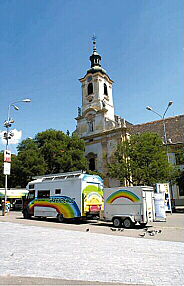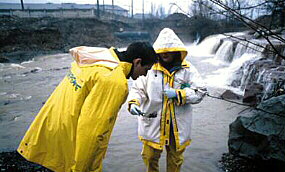 |
| Clean Water Tour 2002 stops over in Bratislava |
In summer 2002, Greenpeace launched its "Clean Water Tour”, a
new awareness-raising campaign in the Danube Basin focusing on industrial
pollution in the Upper Tisza Basin. Greenpeace, whose new strategy includes
co-operation and partnership activities with authorities and industries,
exists to give this fragile Earth the voice that it deserves. The Earth
needs solutions. It needs change. It needs action.
As a global non-profit organisation, Greenpeace is active in 40 countries
worldwide. The organnisation focuses on the most crucial global threats
to our planet's biodiversity and the environment. The organisation has no
permanent allies or enemies and promotes open, informed debate about society's
environmental choices. In pursuing its goals, Greenpeace relies on research,
lobbying and quiet diplomacy, but it does sometimes resort to high-profile,
non-violent conflict in order to raise the quality of public debate.
Environmental campaigning
In 2000 Greenpeace decided to expand its activities, through its Vienna
office, to Central and Eastern Europe, namely to Slovakia, Hungary and Romania.
The reasons are obvious: high pollution on the one hand, and valuable but
endangered natural resources on the other. The pressing need for environmental
campaigning has only been highlighted by the serious gold- mining accident
at Baia Mare that in January 2000 destroyed nearly all life in the Tisza
River.
The "Clean Water Tour 2002”, focusing on the Upper Tisza region,
is the first large-scale project launched by Greenpeace in Central and Eastern
Europe. Before launching the campaign, Greenpeace had conducted a detailed
assessment of all major industrial water pollution hot spots and had consulted
local governmental and NGO experts. As a tangible output of the assessment,
a map was produced of both high-risk and ongoing pollution hot spots including
their detailed description.
A range of diverse international delegations visited Romania in the wake
of the Baia Mare accident, including experts from the EU, national governments,
UNDP, US-EPA and many others. They were all so busy researching facts, talking
to decision makers and promoting themselves that they raised among the local
population and institutions high expectations in terms of support. The expectations
were not met - only some small concrete help came in response to the disaster,
such as the EU "Task Force” report. Greenpeace has found that
as long as two and a half years after the accident nearly nothing has changed
with regard to the pollution it caused, apart from some small-scale local
efforts. This was a sufficient reason for Greenpeace to start campaigning
against water pollution caused by industry.
Greenpeace has come to realise that due to the social, political and historical
differences of the CEE countries, a specific regional strategy is necessary
if concrete environmental improvements are to be made. This strategy must
be clearly based on co-operation and must be solution-orientated. During
the early stage of the project, Greenpeace sought to make positive contacts
with all relevant stakeholders, including the authorities and the polluting
industries. In most cases, some initial reservations the public had towards
Greenpeace were easily overcome.
The "Clean Water Tour 2002”, was actually only the first part
of the three-part clean water project launched by Greenpeace. The tour part
was aimed at increasing public awareness. The Greenpeace bus visited a total
of over 80 towns in Slovakia, Hungary and Romania. Volunteers on board the
bus informed thousands of interested people while chemists analysed countless
drinking water samples. Nitrate and lead were identified as the main contaminants.
Solution-oriented communication
 |
| Working towards a better environment |
The second part of the project consisted of direct actions at industrial
hot spots, which were carried out only in cases when companies initially
refused to cooperate. Two larger actions were conducted at the Somes Dej
paper factory in Romania and the EMV herbicide producer in Hungary. In both
cases, a solution-oriented communication between the environmentalists and
the company was established following the protest and concrete environmental
improvements are now likely to happen.
Apart from these public activities, Greenpeace decided to launch a concrete
fund-raising and lobbying project. The Baia-Mare-based, state-owned mining
company, Remin, was found to be the most suitable partner for such a project.
Remin is the biggest water polluter in the Baia Mare region, willing to
improve the situation but lacking the financial means to do it. Together
with Zinke Environment Consulting, a local expert and the local authorities,
Greenpeace has developed an investment portfolio for seven pollution reduction
projects in Baia Mare and Baia Borsa. Although the total volume of these
projects is only EUR2.5m, they would still reduce the waste water emissions
by 80 %, and the Novat pond risk spot near Baia Borsa, the site of the second
major mining accident in 2000, would be eliminated. This portfolio has been
officially endorsed by the Romanian government and has also triggered the
interest of potential international donors including the EU Delegation,
UNDP and national governments. The Austrian Ministry for Foreign Affairs
is seriously considering co-financing the Baia Borsa project. It is very
likely that several of these projects will be financed in 2003, but more
donors are needed if this window of opportunity is to be opened.
A lot of work still remains to be done, but Greenpeace is committed to continuing
to campaign for a better environment in the Danube region.